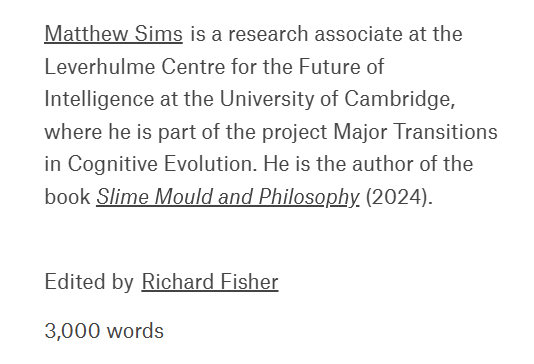Welcome to DU!
The truly grassroots left-of-center political community where regular people, not algorithms, drive the discussions and set the standards.
Join the community:
Create a free account
Support DU (and get rid of ads!):
Become a Star Member
Latest Breaking News
Editorials & Other Articles
General Discussion
The DU Lounge
All Forums
Issue Forums
Culture Forums
Alliance Forums
Region Forums
Support Forums
Help & Search
The DU Lounge
Related: Culture Forums, Support ForumsMemories without brains: What slime mould teaches us about biological memory

Certain slime moulds can make decisions, solve mazes and remember things. What can we learn from the blob?
https://aeon.co/essays/what-can-slime-mould-teach-us-about-biological-memory

Physarum Polycephalum. Photo by Stephane de Sakutin/AFP/Getty Images

During the COVID-19 pandemic, some people took up baking, others decided to get a dog; I chose to grow and observe slime mould. The study in my partner’s flat in Edinburgh became home to two cultures of Physarum polycephalum, an acellular slime mould sometimes more casually referred to as ‘the blob’. I began a series of experiments investigating how long it would take for two separated cell masses from the same bisected Physarum cell to stop fusing with one another upon reintroduction. Hours turned into days, and days into weeks, and, due to time constraints, the experiment eventually fizzled out around six weeks. This, however, was only the beginning. Over that following year (unbeknown to our unsuspecting neighbours), I conducted several more experiments. Although none of them were published, each inspired new philosophical questions – which to this day continue to shape my thinking. One of the core questions was: what can the behaviour of slime mould teach us about biological memory?
The differences between P polycephalum and humans may seem vast, but slime mould can reveal a remarkable amount about various aspects of how we remember. While many people might assume that our memories are primarily stored within our brains, some philosophers like myself argue that – along with some other aspects of cognition – memory can extend beyond the confines of the body to involve coupled interaction with structures in the environment. At least some of our cognitive processes, in short, loop out into our surroundings. Slime mould is an intriguing candidate to explore this idea because it doesn’t have a brain at all, yet in some cases can apparently ‘remember’ things without needing to store those associated memories within itself. In other cases, memories acquired via learning by one individual can even be acquired by a separate individual through physical contact. The behaviour of this strange form of life suggests that some of our ideas about how memories are acquired may need a rethink.
Physarum polycephalum is a blob-like organism belonging to the class Myxomycetes, also known as the ‘acellular slime moulds’. Unlike cellular slime moulds, which are single-celled micro-amoeba that come together when starved to form a giant slug-like aggregation, Physarum is made of one giant mega-cell. It has a complex life cycle consisting of two distinct vegetative stages: a microscopic ‘amoeboflagellate stage’ – emerging after spore germination – and a macroscopic ‘plasmodial stage’. This latter stage, which resembles a bright yellow, veiny paint spill, has become the primary focus of experimental research. This is not only because of its impressive size (reaching up to a hefty 2 square metres) but also because of its surprisingly rapid locomotion – up to 5 cm per hour. Not too shabby for a blob.

P polycephalum plasmodium. Courtesy Wikipedia
It moves across surfaces by oscillatory contractions of internal vein-like tubules that redistribute protoplasm to cell edges, forming outgrowths resembling flattened, yellow, cauliflower-like structures. During the plasmodial stage, Physarum actively forages on microorganisms and decaying matter, two food sources that are readily available in its natural habitat of woodland and forest floors. There, it thrives in moist leaf litter, rotting logs and tree stumps, moving towards and enveloping food sources while avoiding direct sunlight and dry surfaces. For much of its scientific history, Physarum was misclassified as a fungus, primarily due to its ability to produce spores within stalked fruiting bodies, similar to the spore-producing structures of fungi. Its species name polycephalum, literally meaning many-headed, refers to the multiple spore-holding structures (sporangia) of its fruiting body, which superficially resemble tiny heads. However, ultrastructural studies in the 1970s and subsequent molecular phylogenetics in the late 20th century revealed that acellular slime moulds actually belong to the Amoebozoa, a group of unicellular protists more closely related to amoebae than to fungi.

snip
1 replies
 = new reply since forum marked as read
Highlight:
NoneDon't highlight anything
5 newestHighlight 5 most recent replies
= new reply since forum marked as read
Highlight:
NoneDon't highlight anything
5 newestHighlight 5 most recent replies
Memories without brains: What slime mould teaches us about biological memory (Original Post)
Celerity
Jul 12
OP
snot
(11,307 posts)1. Very interesting;
thank you!
I've been wondering about what I call "distributed intelligence" lately – e.g. octopi; or a cutting from a vine that knows how to orient itself w.r.t. gravity, how and where to grow roots, distinguishes light from dark, and even seeks and finds potential supports around which to entwine itself, etc.
![]()